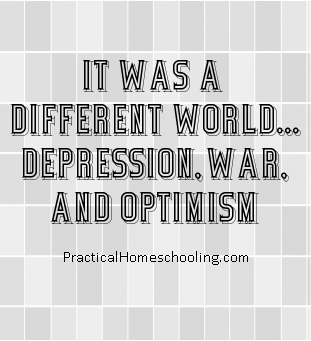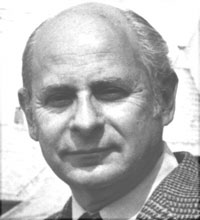High School During the Depression
By Sam Blumenfeld
Printed in Practical Homeschooling #92, 2010.
 Sam tells what it was like going to high school in New York in the early years of World War II.
Sam tells what it was like going to high school in New York in the early years of World War II.

| 
|
What was it like going to high school in the 1940s, when we were still
in the Great Depression and war had broken out in Europe?
 Actually, I had nothing to complain about. Life was beautiful in the
great city of New York. You couldn’t help being optimistic in that great
capital of capitalism, with its fantastic skyscrapers, great movie
theaters, Broadway shows, museums, and huge department stores. Also, it
was a very safe city. You could ride the subway at 2:00 in the morning
and not worry about being robbed or assaulted.
Actually, I had nothing to complain about. Life was beautiful in the
great city of New York. You couldn’t help being optimistic in that great
capital of capitalism, with its fantastic skyscrapers, great movie
theaters, Broadway shows, museums, and huge department stores. Also, it
was a very safe city. You could ride the subway at 2:00 in the morning
and not worry about being robbed or assaulted.
The New York World’s Fair of 1939–40 was a spectacle one would never
forget. Its bold optimism was symbolized by its famous Trylon and
Perisphere. The magnificent General Motors pavilion gave us a view of
the future. It was called the Futurama. We all believed in the greatness
of America’s future, regardless of what was happening abroad.
At age 14, my life was wrapped around going to school. I had been
strongly urged by one of my junior-high-school teachers to apply for
admission to Stuyvesant High School, a prestigious exam school in
Manhattan. I passed the test, but since I lived in the Bronx, it meant
taking the elevated train every day to the school located in lower
Manhattan. The trains were clean and safe and young people behaved like
young ladies and gentlemen.
In those days high schoolers were considered young adults, not
“teenagers.” High school was serious business, and so we dressed like
young adults, behaved like young adults, and our teachers treated us
accordingly. They weren’t trying to drug us, or turn us into functional
illiterates, or destroy our religious beliefs. They respected our
families’ values, and thus earned our respect and affection in return.
Back then there were no school massacres or shootings. Schools were
safe.
At Stuyvesant, academic standards were high and rigorous. We were
serious about education, and there were no bullies or fights. That sort
of thing was for the elementary or middle school. But even in middle
school there wasn’t much of it.
My favorite course was architectural drawing. I was good at it, and my
teacher was very encouraging. I had thought of becoming an architect.
Today, at the age of 83, I remember very few details of my time at
Stuyvesant. Our history teacher had been gassed in World War I. We
studied English literature, history, geometry, trigonometry, French, and
biology. Social studies had not yet invaded the schools of New York;
however, I remember learning that colonialism was a bad thing, even
though multiculturalism was unheard of. There was no such thing as sex
ed. And so I was given about as decent and moral an education as anyone
could have had in the 1940s.
My family’s concern at the time was the fate of our relatives in Poland.
My parents had come to the U. S. in the 1920s. They became strongly
patriotic Americans, grateful for a chance to live life in freedom. The
Nazi invasion of Poland in September 1939 put an end to any plans to
bring some of those relatives to America. They were trapped between the
Nazis and Communists, and were doomed. Thus, it was easy for me to know
something of geography and history as the tragedy in Europe unfolded.
The attack on Pearl Harbor by the Japanese took place on December 7,
1941. I was then 15 years old, too young for the draft. My two older
brothers, however, went into the service. There was no doubt in anyone’s
mind in those days that we would win the war, and the nation was
mobilized to do just that.
In 1944, during my senior year at Stuyvesant, I reached draft age. One
of my teachers urged me to join the Army Specialized Training Program
instead of waiting to be drafted. The ASTP program opened doors to
better military assignments. So I joined.
Believe it or not, I was sent to the Virginia Military Institute at
Lexington, Virginia, where I studied as a military cadet for a semester.
It was a fantastic experience—the first time I was able to see what
another part of America was like. One of my fellow cadets was the
individual who became Mel Brooks, the comedian superstar.
Since I did not show any great military talents, I was sent from VMI to
Fort Sill, Oklahoma, for basic training in the artillery. That too was a
great travel experience. In early 1945, I was assigned to an artillery
unit to be sent to Italy. We boarded our transport at Newport News and
arrived in Italy in March. We encamped near Pisa, in preparation for
combat in the Appenine Mountains near Bologna. Once in place, we began
pounding the German lines.
During that period, we had one casualty. One of our shells exploded as
it exited the cannon killing one of our men: Franklin Pierce Plummer
III. I would never forget his name. He was a nice, unassuming guy from
upstate New York.
In April, the German lines crumbled and the enemy began a hurried
retreat into the Po Valley. Large German units began surrendering, and
by May the war in Europe was over. I then was transferred to an infantry
unit which occupied northern Italy. I became a clerk-typist. Apparently
my touch-typing ability, which I acquired in junior-high school, landed
me the job. Moral of the story: you never know where what you learn will
take you.
Born and educated in New York City, Samuel Blumenfeld has written eight
books on education, including several that are considered homeschool
classics. His phonics program, Alpha-Phonics, and his how-to series, How
to Tutor, are both available from Paradigm, 208-322-4440.